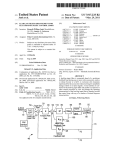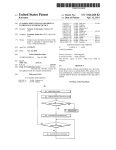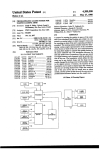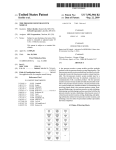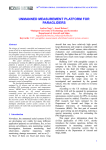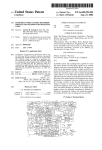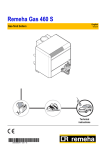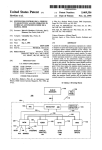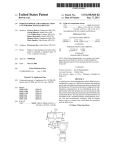Download Multi mode safety control module
Transcript
US008237389B2 (12) Ulllted States Patent (10) Patent N0.: Fitch et a1. (54) (75) US 8,237,389 B2 (45) Date of Patent: MULTI MODE SAFETY CONTROL MODULE _ . 5,229,941 A _ Inventors. Osa Edward Fitch, Nashua, NH (US), 7/1993 Hattori et 31. 5,245,422 A 9/1993 Borcherts et al. 5,400,864 A 3/1995 5,448,479 A Eddle WllllamS, L05 0505, CA (US) (73) Assignee: iRobot Corporation, Bedford, MA (US) Aug. 7, 2012 Winner et al. 9/1995 Kemner et a1‘ 5,469,356 A 11/1995 Hawkins et al. 5,471,560 A 11/1995 Allard et a1. 5,485,892 A 1/1996 Fujita et a1~ (Continued) (*) Notice: Subject to any disclaimer, the term of this patent is extended or adjusted under 35 U.S.C. 154(b) by 834 days. FOREIGN PATENT DOCUMENTS 3404202 A1 5/1987 DE (Continued) (21) Appl. N0.: 12/269,868 _ OTHER PUBLICATIONS (22) F1led: Nov. 12, 2008 Murray, Sean et a1., “Continued Research in EVA, Navigation, Net (65) Prior Publication Data Working and Communications Systems”, SAE Proceedings, Interna tional Conference on Environmental Systems, Jun. 2008. US 2010/0117585 A1 May 13, 2010 (Continued) (51) Int. Cl. (52) us. Cl. ................. .. 318/563; 318/568.12; 180/271; (58) Field of Classi?cation Search ................ .. 318/563, G05B 9/02 (200601) Primary Examiner * Walter Benson 701/45 318/568.11, 568.12, 590, 591; 701/36, 45, 701/52; 180/271; 361/1 See application ?le for Complete Search hiSIOI'Y_ (56) (74) Attorney, Agent, or Firm * O’Brien Jones PLLC (57) ABSTRACT A robotic assembly comprises: a mobile vehicle including mechanical components con?gured to operate the mobile vehicle in a manual mode of operation; a main poWer circuit References Clted for distributing a poWer signal to the electromechanical com ponents and to external modules; an automation module con U.S. PATENT DOCUMENTS 2,466,375 A Assistant/Examiner * Antony M Paul nected to the mechanical components and operable to control 4/ 1949 Carbon _ and operate the mechanical components, and a poWer circuit 2 gttenstem 4’ 1 55’4 17 A 5/1979 zitéirllsstem and the external modules; a safety control module connected 432023037 A 5/1980 Glaser et 31‘ to the main poWer circuit, the automation module, and the 4,361,202 A 4,897,640 A 2,35%’ con?gured to distribute poWer to the mechanical components 11/ 1982 Minovitch mechanical components; a mode selector connected to the 1/ 1990 Rapoen et a1~ main poWer circuit; and emergency stop switches con?gured 2 girt?eltet 2:151 5’076’382 A 0/1991 ‘4151;131:311 ' cal components and external modules in response to actuation 5,170,352 A 12/1992 McTamaney et a1. Ofthe emergency StOP buttons 5,198,973 A 3/1993 Steutermann 5,204,814 A 4/1993 Noonan et a1. to prevent a How of current to substantially all of the mechani 8 Claims, 7 Drawing Sheets 1 _________________________________________ — ‘1 : 1 i : r__/15 60:33:31]“ 601433236 2 ( '| 35 l : (N5 Mimi/1n | ___ : 1 r\/1o 56 Safety Control MGGUIE : 409‘ _ Autornanon Kit l I Vehicle Main | PowerOirouit ' I | | ' I I I I l I | | l l l l | 1 I [_ Automation : I Kt Kit 29., 1 I | 1 1 | 1 I I ' Mobile Vemcle l | 1 1 US 8,237,389 B2 Page 2 U.S. PATENT DOCUMENTS 5,508,689 5,511,147 5,555,503 5,586,030 5,646,843 5,652,849 5,675,229 5,698,823 5,774,069 A A A A A A A A A 5,784,023 A 5,906,645 A 5,984,880 5,987,364 6,037,901 6,038,496 6,059,063 6,072,248 6,083,020 4/1996 4/1996 9/1996 12/1996 7/1997 7/1997 10/1997 12/1997 6/1998 EP EP EP EP GB GB GB GB JP 7/1998 Bluege 5/1999 Kagawa et al. JP JP JP JP W0 W0 W0 A A A A A A A 11/1999 11/1999 3/2000 3/2000 5/2000 6/2000 6,108,031 A 8/2000 6,113,395 A 6,151,239 A 6,169,940 Bl Launder et al. Le Gusquet et al. Devier et al. Dobler et al. ShimiZu et al. Muise et al. 7/2000 MOI , \(gumstmp et a1‘ , 0 601 728 0 681 230 0 835 797 1 481 945 2 128 842 A 2 332 286 2 339 869 2 400 454 3-282712 40001 5/2001 6/2001 6/2001 Rowe et 31‘ Das et al. DilZ et al. Arias-Estrada 6,259,980 B1 6,292,725 B1 7/2001 Peck et a1~ 9/2001 Kageyama et al. 6,434,462 B 1 8/2002 Belvy et a1‘ 6,438,491 B1 8/2002 Farmer Til/£11152‘? al' 6,442,476 6,445,983 6,453,223 6’480’762 6,535,793 6,549,130 B1 B1 Bl B1 B2 B1 6,577,909 6,600,986 6,631,882 6,633,800 B1 B2 B2 B1 6,694,260 B1 8/ 2002 9/2002 9/2002 1 H2002 3/2003 400% 6/1996 3/1997 6/1999 4/2000 2/1999 4/2001 10/2004 OTHER PUBLICATIONS _ _ _ Yamauchi, Brian. “All-Weather Perception for Small Autonomous UGVs”. In Proceedings of SPIE Defense and Security Conference, Orlando, FL, Mar‘ 2008‘ Lenser, Scott et al., “Practical problems in sliding scale autonomy: A lIlSlOW B1 B1 B1 B1 6/1994 11/1995 4/1998 12/2004 8/1983 6/1999 2/2000 10/2004 12/1991 8-156641 9-258826 11149315 A 2000094373 A WO 99/05580 WO 01/26338 A2 WO 2004/086084 King et al. 9/2000 Hon 11/2000 Batra 1/2001 Jitsukata et al. 2133’ 6,223,110 6,233,504 6,249,215 6,253,161 FOREIGN PATENT DOCUMENTS Rado et al. Abdel-Malek Kyrtsos et al. Kemner et al. Gudat et al. Conway et al. Thorne Tanahashi Tanaka et al. . . case study”. In Proceedings of SPIE Defense and Security Confer 91199, Orlando, FL, Mar, 2008, Cheung, Carol et al., “UAV-UGV Collaboration With a PackBot UGV and Raven SUAV for Pursuit and Tracking of a Dynamic Target”. In Proceedings of SPIE Defense and Security Conference, Orlando, FL, Mar‘ 2008‘ Schoenfeld. Erik et al., “Door Breaching Robotic Manipulator”. In Proceedings of SPIE Defense and Security Conference, Orlando. FL, Mar 2008 Poropat et al. Dickson et 31~ et al. Uchlkubo et a1‘ Allard Joao Yamauchi, Brian. “Daredevil: Ultra Wideband Radar Sensing for Small UGVs”, In Proceedings of SPIE: Unmanned Systems Tech nology IX, Orlando, FL, Apr‘ 2007‘ Rudakevych, Pavlo et al, “Integration of the Fido Explosives Detector . onto the PackBot EOD UGV”, In Proceedings of SPIE vol. 6561, 6/2003 McGowan et al. Man 200? Rudakevych, Pavlo et al., “A man portable hybrid UAV/UGV sys tem”, In Proceedings of SPIE vol. 6561, Mar. 2007. Jones, Chris et al., “Sentinel: An Operator interface for the Control of 7/2003 steinle et a1, 10/2003 Mack 10/2003 Ward et a1~ 2/2004 RekQW Multiple Semi-Autonomous UGVs”, In Proceedings of the Associa glscrli et 31' 6,778,097 B1 6,789,014 B1 8/2004 Kajita et al. 9/2004 Rekow et a1‘ tiAoln fggolénmanned Vehicles Systems International. Orlando, FL, Y g‘ h. ‘B . “A U b R . U . M amauc i, rian. utonomous r an econnaissance sing an 6,813,557 B2 110004 Schmidt et 31‘ Portable UGVs”, In Proceedings of SPIE: Unmanned Ground 6,845,297 B2 6,873,911 B2 1/2005 Allard 3/2005 Nishira et a1, Vehicle Technology VIII, Orlando, FL, Apr. 2006. Yamauchi, Brian. “Wayfarer: An Autonomous Navigation Payload 6,882,155 B2 * 4/2005 LaZZaro ...................... .. 324/418 for the PackBot”, In Proceedings of AUVSI Unmanned Vehicles 6,898,542 B2 5/2005 Ott et al. North America 2005, Baltimore, MD, Jun. 2005. 6,901,319 6,902,021 6,945,346 6950382 5/2005 6/2005 9/2005 9/2005 Barnes, Mitch et al., “ThroWBot: Design Considerations for a Man Portable ThroWable Robot”, In Proceedings of SPIE vol. 5804, Mar. 2005‘ Rudakevych, Pavlo et al., “PackBot EOD Firing System”, In Pro B1 B2 B2 Bl 7,010,450 B2 Nelson _et a1~ Klkuchl et a1~ Massen et al. Weber et 31' 3/2006 Law et al. - 7,015,831 B2 3/2006 Karlsson et al. ceedmgs 9f SPIE V01‘ 5804’ Mar‘ 2005' 7,079,021 B2 7/2006 snowbarger et a1‘ Yamauchi, Brian. “The Wayfarer Modular Navigation Payload for 7,278,567 B2 7,305,294 B2 7,894,951 B2 * 10/2007 Ferguson et a1‘ 12/2007 Bate et a1‘ . . Intelligent Robot Infrastructure”, In Proceedings of SPIE vol. 5804; Unmanned Ground Technology VII, Orlando, FL, Mar. 2005. 2/2011 Norris et a1, ,,,,,,,,,,,,,,,,,, H 701/36 Yamauchi, Brian et al., “Griffon; aman-portable hybrid UGV/UAV”, 200 1/ 0018640 A1 2002/0032511 A1 8/ 2001 Matsunaga 3/ 2002 Murakarni et al. In Industrial Robot: An International Journal, vol. 31 No. 5, 2004. Yamauchi, Brian. “PackBot: AVersatile Platform for Military Robot ics”, In Proceedings of SPIE vol. 5422: Unmanned Ground Vehicle 2002/0104300 A1 55/2002 Hllnt 2003/0080772 A1 2004/0061596 A1 5/2003 Giacomini et al. 4/2004 Egan“ Technology V1, Orlando, FL, Apr‘ 2004, Sword, Lee et al.. “Mobility Enhancements for Ballistically 2004/0114584 A1 2004/0158355 A1 6/2004 PatZ et 8/2004 Holmqvlst et a1‘ Deployed Sensors”. In Proceedings of SPIE vol. 4393, Apr. 2001. R dakev ch Pavlo “Wave Control‘ A Method of Distributed Con 2004/0158379 8/2004 A1 2004/0168837 A1 _ _ Horbaschek 9/2004 Michaud et a1‘ “ y ’ ' . ,, ' . :01 folrglggpeated Unit Tentacles , In Proceedings of SPIE vol. 3839, ug. . 1825153625211" Rudakevych, Pavlo et al., “Micro Unattended Mobility System 2005/0092542 A1 2005/ 0159870 A1 5/2005 Turner 7/ 2005 Tohdo et al. (MUMS)”, In Proceedings of SPIE vol. 3713, Jul. 1998. SafeStopTM Wireless Emergency Stop System brochure, TORC 2008/0121097 A1 * 5/2008 Rudakevych et al. ..... .. 89/28.05 Technologies, LLC., copyright 2008, undated. US 8,237,389 B2 Page 3 SafeStopTM User Manual, Revision 2.1, SafeStopTM ES-220 Wireless Emergency Stop, TORC Technologies, LLC., copyright 2007, undated. De Campos, Institute of Electrical and Electronics Engineers, “Per ception Planning as a Distributed Decision-Making Process,” Oct. 17-20, 1993, vol. 3, pp. 611-616. Corbett, G.K., et al., “A Human Factors Tested for Ground-Vehicle Telerobotics Research,” Southeastcon '90 Proceedings, vol. 2, pp. 618-620, 1990. Shimoga, et al., “Touch and Force Re?ection for Telepresence Sur gery,”IEEE, pp. 1049-1050, 1994. Mair, “TelepresenceiThe Technology and Its Economic and Social Implications,” IEEE, pp. 118-124, 1997. Ohashi et al., “The Sensor Arm and the Sensor Glove IIiHaptic Devices for VR Interface,” IEEE, p. 785, 1999. Green, P.S., et al., “Telepresence Surgery,” IEEE, Engeneering in Medicine and Biology, pp. 324-329, May/Jun. 1995. Nakai, et al., “7 DOF Arm Type Haptic Interface for Teleoperation and Virtual Reality Systems,” Proceedings of the 1998 IEEE/RS] INTL. Conference on Intelligent Robots and System, pp. 1266-1271, 1998. * cited by examiner US. Patent Aug. 7, 2012 cosmEq. (Q. HE Sheet 1 of7 Pi US 8,237,389 B2 £952 US. Patent Aug. 7, 2012 Sheet 3 of7 US 8,237,389 B2 430 Wait for Vehicle Power Switch to Turn On a: Main Vehicle Power Switch On? Power the Manual Assembiy 442 11-4-4 Power Stop Button ~ DOW" Depressed? In Automatic ' Mode? Power the Automation \ Assembty M oment-ariiy Energize the 450 J Hold Down Q / R eiay i Power the Manual Assembiy 452J Power the Emergency Shutdown 454 J -' Assembiy |___......_ FIG 3 US. Patent Aug. 7, 2012 Sheet 4 of7 US 8,237,389 B2 472 Emergency Stop Button Depressed In AutomaticEnd 474 Mode’? Disrupt Current Flow to the E-Stop Redundant Relay Assembly E-Stop Relay AtSlop leastRedundant one relay inRelay the E Fault Assembly Open? 496 J ' 480 Remove Power From the Manual Assembly l, Disrupt Current Flow tothe Hold-Down Relay Hold-Down Relay Fault Holcl- Down Relay ~ ' 482 484 Open? 486 Disrupt Current Flow to the; Automation Assembly Relay l Remove Power From the Automation Assembly 488 t 490 Remove Power From the Central Control Assembly Main Computer ' Power Switch On? 499 J Power the Central Control Assembly FIG4 492 US. Patent Aug. 7, 2012 Sheet 6 of7 US 8,237,389 B2 305 Instrument Panel Auto Man Engine Oil " Pressure Reset‘ Mode Seiect llllllillllil Temp 0_—25U F IIIIIHIIIIII 0 — 150 PS! - Water RPM X 100 0-60 mmmlm voitc Gear OH ‘ _ q10 5° Temp 0 _ 250 F llllillllliil (F W 0 FIG 6B US. Patent Aug. 7, 2012 Sheet 7 of7 US 8,237,389 B2 380 FIG 7 US 8,237,389 B2 1 2 MULTI MODE SAFETY CONTROL MODULE and the external modules; a safety control module installed on the mobile vehicle and connected to the main poWer circuit, the automation module, and the mechanical components; a INTRODUCTION mode selector sWitch included in the safety control module and connected to the main poWer circuit; and emergency stop sWitches connected to corresponding emergency stop buttons and the mode selector sWitch, and con?gured to prevent a How of current to substantially all of the mechanical compo This invention relates generally to circuits and assemblies for controlling the How of poWer through a semi-autonomous mobile vehicle. In particular, embodiments of this invention relate to multiple mode control modules that control the How of poWer through the electrical and mechanical systems nents and external modules in response to actuation of the included in a semi-autonomous vehicle according to a chosen mode, and a control module that further provides an emer emergency stop buttons. An operational mode of the mobile vehicle changes in response to actuation of the mode selector sWitch. gency stop assembly for removing poWer from substantially all of the electrical and mechanical systems of the semi The present teachings also provide a system for controlling autonomous vehicle. the distribution of poWer Within a mobile vehicle. The system comprises: mechanical components of the mobile vehicle BACKGROUND Safety control systems are included in most process-con trolled assemblies to provide the assemblies With the ability to shut doWn. Multiple types of safety systems exist. Emergency 20 stop safety systems typically operate to remove poWer from the entire assembly, While other safety systems may stop the How of liquid or gas, or otherWise stop the process being controlled. Emergency stop safety systems typically found in industrial applications are connected directly to the main system’s source of poWer. Sensors included in the safety 25 system are able to detect failure conditions Within the assem bly and responsively activate the safety system, Which in turn removes poWer from the assembly. Industrial applications that employ an emergency stop safety system rely on the system’ s ability to interact With the application and further safely redistribute all poWer out of the 35 safety system into the larger process controlled application. Such a con?guration can be disadvantageous because it pro vides no alternative to removing poWer from the entirety of the system. Additionally, safety systems that integrate the 40 emergency stop safety system can be application speci?c, not versatile, and require costly and often complicated installa tion. Electro-mechanical systems similarly utiliZe emergency stop safety sub-systems that remove all poWer from the main 45 system When an emergency event is detected. It may be inap propriate to design an autonomous vehicle that responds to an emergency event by removing poWer from all components Within the autonomous vehicle. Such a design Would fail to address the need for an autonomous vehicle to retain a level of 50 autonomy despite encountering an emergency event that causes a poWer loss. Autonomous vehicles rely on control systems included Within vehicle to continue collecting data and to further provide the user and vehicle With a system through Which the autonomous vehicle can communicate. automation assembly, the mechanical components, the emer gency stop buttons, and the main poWer circuit, the safety assembly. Furthermore, these applications typically integrate circuits and mechanical systems necessary to implement an mobile vehicle, connected to the mechanical components and to the main poWer circuit, and con?gured to control and operate the mechanical components and distribute poWer from the main poWer circuit to the mechanical components; emergency stop buttons installed on the mobile vehicle and connected to emergency stop sWitches responsive to actua tion of the emergency stop buttons; and a safety control mod ule installed on the mobile vehicle and connected to the 30 applications’ components to stop current flow through the the components necessary to implement the emergency stop con?gured to operate the mobile vehicle according to a user de?ned mode of operation; a main poWer circuit of the mobile vehicle con?gured to transmit a poWer signal to the mechani cal components and to external modules connected to the mobile vehicle; an automation assembly installed on the 55 control module including a mode selector sWitch for altering the mobile vehicle’s mode of operation. The present teachings further provide a poWer control sys tem comprising: a safety control module enclosed at least partially in a housing comprising mounts for mounting the safety control module to a surface, the housing also compris ing connectors and plugs con?gured to mate With external assemblies and connect With circuits of the safety control module; a mode sWitch circuit having a mode selector sWitch designed to change an operative mode of the safety control module in response to actuation thereof, a main poWer circuit connected to a poWer source and con?gured to provide poWer to a central control assembly included in an external automa tion assembly; and an emergency stop sWitch con?gured to activate a shutdoWn process When actuated, the shutdoWn process removing poWer from a manual assembly, redirects a poWer signal provided to the automation assembly, and ener giZes the central control assembly. The mode sWitch circuit is con?gured to distribute poWer to the safety control module according to the operative mode. Certain advantages of the present teachings Will be set forth in part in the description Which folloWs, and in part Will be obvious from the description, or may be learned by practice of the present teachings. The advantages of the present teach SUMMARY ings Will be realiZed and attained by means of the elements The present teachings provide a mobile vehicle compris ing: mechanical components con?gured to operate the mobile claims. It is to be understood that both the foregoing general description and the folloWing detailed description are exem plary and explanatory only and are not restrictive of the present teachings, as claimed. and combinations particularly pointed out in the appended 60 vehicle in a manual mode of operation; a main poWer circuit in the mobile vehicle for distributing a poWer signal to the electromechanical components and to external modules The accompanying draWings, Which are incorporated in installed on the mobile vehicle; an automation module con nected to the mechanical components and operable to control and operate the mechanical components, and a poWer circuit con?gured to distribute poWer to the mechanical components 65 and constitute a part of this speci?cation, illustrate one several embodiments of the present teachings and, together With the description, serve to explain the principles thereof. US 8,237,389 B2 3 4 BRIEF DESCRIPTION OF THE DRAWINGS The safety control module also provides a system for ini tiating an emergency shutdoWn of the vehicle and the vehi cle’s associated components While providing a minimum level of autonomy. Included in the safety control module is a FIG. 1 is a block diagram of an exemplary embodiment of circuits and assemblies included in the mobile vehicle and their interconnections and connections With a safety control module. FIG. 2 is a schematic diagram of an exemplary embodi ment of a safety control module in accordance With the main computer circuit poWered directly by the vehicle’s poWer source and unconnected to the emergency shutdoWn system. Connected to the main computer circuit is a central control assembly con?gured to record system data and further provide a control system able to communicate remotely With present teachings. a user and provide a minimum level of autonomous control FIG. 3 is a How diagram depicting an exemplary embodi ment of a How of poWer through the safety control assembly. FIG. 4 is a How diagram illustrating an exemplary embodi over the vehicle and its associated components. button is depressed. The safety control module further provides a system Where the safety control module is contained Within a rugged hous ing such that the safety control module can be mounted on the FIG. 5 is a How diagram illustrating an exemplary embodi ment of a method implemented When the reset mode is cho surface of the vehicle and interface With the vehicle via a system of external cables and connectors. ment of a method implemented When an emergency stop Certain embodiments of the present teachings provide a sen. safety control module used in combination With an automated mobile vehicle for responding to emergency events by remov FIG. 6A illustrates an exemplary embodiment of a safety control module housing and display panel in accordance With the present teachings. 20 FIG. 6B illustrates an exemplary embodiment of mounting brackets included on a safety control module base in accor dance With the present teachings. FIG. 7 illustrates an exemplary embodiment of a safety control module mounted to a dashboard of a mobile vehicle. 25 a manual operation mode, a user can operate the mechanical assemblies. Automation of the mobile vehicle can be accom DETAILED DESCRIPTION Reference Will noW be made in detail to the present exem plary embodiments of the present teachings, examples of Which are illustrated in the accompanying draWings. The safety control module provides a system for control ling distribution of poWer throughout an automated vehicle. Included Within the safety control module is an assembly of circuits and mechanical systems designed to distribute poWer to the modules and assemblies connected to the safety control module. In particular, the assembly of circuits and mechani cal systems distribute poWer to mechanical systems included 30 35 in the autonomous vehicle and necessary to operate the autonomous vehicle manually. These mechanical systems receive poWer from the safety control module When the safety control module operates in a manual mode. When operating in an automatic mode, the mechanical systems receive poWer in part from an automation assembly connected to the safety control module, and in part from the safety control module. The safety control module provides a system for operating the circuits and mechanical assemblies included in the safety control module, the autonomous vehicle, and the modules safety control module, Where the automation assembly fur ther controls the operation of substantially all the systems plished by an automation module that includes an automation assembly connected to the mechanical assemblies in the mobile vehicle. The circuits and routines included in the automation module can be con?gured to operate and control various mechanical and electrical systems of the mobile vehicle such that the mobile vehicle operates autonomously according the automation module’s circuits and routines. In accordance With certain embodiments of the present teachings, the safety control module can comprise a safety control assembly including circuits and mechanical assem blies enclosed Within a rugged housing. The housing can be rated for military or industrial use, can be con?gured to 40 reduce heat and shield the internal safety control assembly from electromagnetic noise, and can be ?tted With external mounts and rails to mount the safety control assembly to a surface. Optionally installed on the housing are a plurality of connectors and plugs, Which can be rated for military or 45 industrial use and can mate With a variety of communication links. Communication links can include Wires and cables, but can alternatively include a Wireless signal or other connection and assemblies connected to the safety control module in a user-de?ned mode. Alteration of the mode of operation is accomplished by actuating a mode selection sWitch. When in an automatic mode, the safety control module distributes a poWer signal to an automation assembly connected to the ing poWer from all non-essential systems and assemblies While continuing to provide poWer to essential control sys tems Within the vehicle’s automation module. Mechanical assemblies installed in the mobile vehicle to facilitate manual operation of the vehicle can be connected to the safety control module such that When the safety control module operates in 50 link able to relay signals from an external module or assembly to modules and assemblies included in the safety control module via a communication link connected to the safety control module via a connector or plug installed on the safety control module’s housing. 55 In accordance With certain embodiments of the present teachings, installed Within the safety control module is a mode selection circuit that includes a sWitch With positions included in the automated mobile vehicle to automate the corresponding to a predetermined number of, for example operation of the vehicle and the assemblies connected to the vehicle. The safety control module further provides a system for initiating an emergency shutdoWn of the vehicle and the vehi cle’s associated components When an emergency stop button connected to the safety control module is actuated. The emer gency shutdoWn is facilitated by an emergency shutdoWn system con?gured to disrupt the How of poWer to the electri cal and mechanical systems included in the autonomous vehicle to shut doWn the vehicle and the vehicle’s compo three, modes. These modes can include a manual mode of operation, an automatic mode of operation, and a reset mode nents. 60 of operation. When the sWitch in the mode selection circuit is actuated, the safety control module and the modules and assemblies connected to the safety control module, can oper ate according to the chosen mode. The manual mode of opera tion can, for example, enable a circuit con?guration Whereby 65 the mechanical assemblies and electrical circuits included in the mobile vehicle and able to operate the vehicle manually, are poWered via the vehicle’s main poWer sWitch. Thus, While the safety control module is in a manual operation mode, a US 8,237,389 B2 5 6 user is able to operate the mechanical assemblies and electri assembly With connectors installed directly on the circuits and assemblies included in the safety control assembly. Still cal circuits necessary to operate the vehicle manually. An automatic mode of operation can be characterized by autono mous operation of, for example, substantially all the other embodiments may include an embodiment of the safety control module 10 Where the circuits and assemblies included mechanical assemblies and electrical circuits included in the in the module are integrated directly into mobile vehicle, and mobile vehicle. The automatic mode can enable the assem do not include connectors or plugs. Further embodiments of the safety control module 10 may include connectors that are blies included in the automation module to control the opera tion of the mobile vehicle according to stored routines and according to user and system commands. not rated for military or industrial use, or connectors and plugs that are alternatively or additionally chosen based on their ability to pass various levels of current. In accordance With certain embodiments, the safety control According to certain embodiments of the present teach module can further include a series of emergency stop (E-Stop) buttons and corresponding sWitches able to break ings, the vehicle’ s main poWer circuit 30 can be connected to the safety control module 10 via a poWer connector 58. This circuit 30 can be the poWer source for the mobile vehicle 5, the the connection betWeen the mode selection circuit and addi tional safety control module circuitry When actuated. Dis rupting the connection betWeen the mode selection sWitch and the circuits and assemblies included in the safety control safety control module 10, the automation assembly 20, the manual assembly 15, and the emergency shutdoWn assembly 25. When the poWer sWitch included in the circuit 30 is in an assembly further causes a disruption of current to these cir cuits and assemblies. The net effect can be removal of poWer from the circuits and assemblies that are dependent on their physical connection With the mode selection circuit for poWer. Various embodiments contemplate a connection With the mode selection circuit characterized by a Wire, While other embodiments may include an alternative physical connection such as an integrated circuit, or a non-physical connection established via an electrical pulse or created via a softWare “off ’ position, no current is passed to the circuits and assem blies connected to the main poWer circuit 30. The poWer 20 connector 58 can, for example, be rated to accept voltages Within a range of 12 volts to 48 volts. The connector 58 can, for example, be rated for military or industrial use and can include a locking mechanism con?gured to lock the connec tive cable’ s connector together With the poWer connector 58. 25 Alternative embodiments of the safety control module 10 can routine con?gured to redistribute poWer throughout the safety include a poWer connector 58 comprising one of a ring ter control module. In accordance With certain embodiments, removal of poWer accomplished via actuation of an E-Stop button serves to shut doWn substantially all systems included in the mobile vehicle and in assemblies and modules connected to the minal, a push-on terminal, a junction block, a spade terminal or another type of mechanical structure able to connect an 30 external Wire or cable to the safety control module 10. Connectors can also be provided to connect the manual mobile vehicle, including the safety control module. assembly 15 and the automation assembly 20 to the safety control module 10. The manual assembly connector 56 and Although the mobile vehicle may operate in a manual mode, the automation assembly connectors 52 can be rated for certain embodiments of the robotic system may retain a level of autonomy after an E-Stop button is actuated. This level of industrial or military use and can be connected to connection 35 autonomy can be accomplished by the main computer circuit, Which can be directly connected to the vehicle’s main poWer circuit, and Which can also be connected to the central control circuit included Within the automation assembly. The ability to communicate remotely With the vehicle and record essen tial system data associated With the emergency shutdoWn of the mobile vehicle can be facilitated by the central control 40 can be a poWer connection Where the circuits Within the safety 45 50 In accordance With certain embodiments of the present teachings, the manual assembly 15 and the automation assembly 20 can include one or more components. One or 55 rated for industrial or military use to ensure that the connec safety control module 10 may include a rugged housing able to accommodate a Wiring interface Whereby external modules and assemblies Would be connected directly to the safety control module’s internal circuits and assemblies. Still other embodiments may include a safety control assembly inte grated directly into a mobile vehicle or other module or sys tem. These embodiments Would include a safety control circuits Within the safety control assembly 10 distribute poWer and data to the automation assembly 20 according to the operative mode and according to data generating events and statuses. ule 10 and the external modules or assemblies to Which the external cables are linked. The connectors and plugs can be tors are both strong and durable. Other embodiments of the control assembly 10 distribute poWer to the manual assembly 56 according to the operative mode. Further, the connection betWeen the automation assembly 20 and the safety control assembly 10 can be a poWer and data connection such that trol module 10 installed on an automated mobile vehicle 5 and additional modules and assemblies included on the mobile vehicle 5. The safety control module 10 can be, in certain embodiments, a stand-alone structure that includes a safety control assembly enclosed Within a housing that is further ?tted With connectors and plugs able to mate With external Wires, cables, and other connection links. Each connector or plug included on the housing can be con?gured to mate With external cables With corresponding connectors, to establish a communicative connection betWeen the safety control mod tor 56 can be con?gured to transmit poWer signals, the auto mation assembly connectors 52 can be con?gured to transmit both poWer and data signals. Thus, the connection betWeen the manual assembly 56 and the safety control assembly 10 circuit, Which can remain poWered by the main computer circuit despite the emergency shutdoWn. Displayed in FIG. 1 is a block diagram illustrating an exemplary embodiment of connections betWeen a safety con links included in the safety control assembly to establish a physical and electrical connection betWeen the manual and automation assemblies and corresponding circuits in the safety control assembly. While the manual assembly connec 60 more manual components 35 included in the manual mode assembly 15 can correspond to the various electrical and mechanical assemblies included in the vehicle 5 to enable a user to operate the vehicle manually. Exemplary manual com ponents 35 can include, for example: circuitry dedicated to a fuel shut-off solenoid; a steering motor; and a throttle assem bly. These components can be poWered and controlled by the 65 automation assembly 20 When the vehicle 5 operates in an autonomous mode. HoWever, When in a manual mode, the manual components 35 can be controlled by a user, and poW ered via a connection With a manual relay 224 included in the safety control module 10. The manual mode of operation can alloW a user to operate the vehicle 5 as they Would Without US 8,237,389 B2 7 8 robotic control and an emergency backup system. Alternative In various embodiments, the mode sWitch circuit 202 can be connected directly to the vehicle’s main poWer circuit 30 such that current ?oWs from the vehicle’ s main poWer circuit embodiments of the system can include a manual mode of operation allowing the automation assembly 20 to have semi autonomous control over aspects of the vehicle’s operation, 30 through the mode sWitch circuit 202 and further through While the user has control over other aspects. the mode selector sWitch 345. When the mode selector sWitch 345 is actuated, the path of the current can be altered such that current ?oWs through a chosen mode pin. An exemplary situation is one Where the mode selector sWitch 345 is actu ated so that an automatic mode is chosen. In this situation, current can ?oW from the vehicle’s main poWer circuit 30, through the mode selector sWitch 345, to the automatic mode pin 206. Circuits and assemblies connected to the automatic mode pin 206 can therefore receive current When the sWitch Similar to the manual mode assembly 15, the automation assembly 20 can include a number of individual automation kits 40. The vehicle 5 can be ?tted With a single automation assembly 40 able to control the operation of most of the vehicle’s electrical and mechanical assemblies. The automa tion kits 40 can provide control circuits and routines able to automate operation of the vehicle and poWer the manual components 35 and other assemblies and systems included on the vehicle 5 and necessary to operating the vehicle 5 autono 345 is an automatic mode. In certain embodiments, a Wire can connect the manual mously. Alternative embodiments of the vehicle 5 may include multiple kits 40, Where each kit 40 is dedicated to controlling vehicle component subsets. Still other embodi mode pin 204 to the manual mode relay 224. Within the manual mode relay 224, the Wire can further connect the ments of the vehicle 5 can include additional kits 40 dedicated to the operation of manipulators and actuators installed on the 20 magnetic force created When the inductance coil is charged via the Wire connecting the manual mode pin 204 to the manual mode relay 224. When closed, the sWitch can remain vehicle 5, such as a head, an arm, or a movable neck. In various embodiments, the emergency shutdoWn assem bly 25 includes a string of emergency stop (E-Stop) buttons 45 that can be, for example, connected in series and con?g ured to send an electrical pulse to the safety control module 54 When one of the buttons is depressed. Each button 45 can be connected to a sWitch so that When the button 45 is depressed, closed until current is removed from the inductance coil, 25 returns to an open position. 30 mode relay 224 via a connecting Wire 270 linking the poWer connector 58 to the closed position pin on the manual mode relay 224. A Wire 256 can connect an open position pin on the 35 spring-loaded connector 54 can open the circuit and connect additional E-Stop buttons 45 When additional E-Stop buttons 45 are connected to the safety control module 10 via the connector 54. When connected, the E-Stop buttons 45 can be placed in series With an E-Stop sWitch 220 included in the manual mode relay 224 to the redundant E-Stop relay assem bly 222. This con?guration can operate so that When the manual mode relay 224 is open, the manual mode relay 224 is part of a circuit that includes all components connected to the automatic mode pin 206, and the manual mode assembly 15 40 safety control assembly of the safety control module 10. Safety Control Module In certain embodiments, the safety control module 10 can be a stand-alone system, fully enclosed Within a rugged hous ing 305. Individual circuits and assemblies included Within In certain embodiments of the present teachings, the vehi cle’s main poWer circuit 30 can be connected to the manual control module 10 When no additional E-Stop buttons 45 are connected to the safety control module 10. Alternatively, the further eliminating the magnetic ?ux and corresponding mag netic force. A counterforce generated by a spring or other type of force-storing component in response to the elimination of the magnetic ?ux can reposition the sWitch so that the relay the sWitch is actuated. A connector 54 can be included on the safety control module 10 to connect the emergency shutdoWn assembly 25 to the safety control module 10. Inclusion of multiple E-Stop buttons 45 is optional and the connector 54 can include an industrial grade, spring-loaded contact that terminates and closes a circuit included Within the safety manual mode pin 204 to an inductance coil included Within the manual mode relay 224. The manual mode relay 224 can be a normally open relay that closes a sWitch in response to a 45 the safety control module and con?gured to receive signal can be poWered by the poWer control circuits and assemblies included in the automation assembly. An alternative circuit can be created When the manual mode relay 224 is closed such that the vehicle main poWer circuit 30 is connected in series With the manual mode assembly 15. This circuit layout can alloW the manual mode assembly 15 to be poWered and con trolled by an autonomous control system When the safety inputs from external circuits and assemblies, can be con control module 10 is in an automatic mode. In a manual mode, nected to connectors and plugs 52, 54, 56, 58 that connect external Wires and other communication links to the safety control module 10. An exemplary embodiment of the safety control module 10 is illustrated in FIG. 2. The mode sWitch circuit 202 installed hoWever, the manual mode assembly 15 can be poWered directly by the vehicle’s main poWer circuit 30, so that the 50 220, the E-Stop button assembly 25, the redundant E-Stop relay assembly 222, the hold-doWn relay 216, and the auto at the center of the safety control module 10 can control the module’s operative mode by re-distributing poWer through out the circuits included Within the safety control module 10 according to the chosen mode. Modes can be chosen via the mode selector sWitch 345, Which can be, for example, a three pin selector sWitch included Within the mode sWitch circuit 202, and Which can be operated by turning the sWitch’ s exter nal dial installed on the front panel 350 of the safety control module housing 305. Each pin Within the mode selector 55 60 sponding to the current chosen mode of operation. vehicle main poWer circuit 30, the manual assembly 15, the emergency shutdoWn assembly 25, the automation assembly 20, the mode sWitch circuit 202, the main computer poWer sWitch circuit 210, the E-Stop sWitch 220, the redundant E-Stop relay assembly 222, the hold-doWn relay 216, and the 206, and a reset pin 208. When the mode selector sWitch 345 module’s operative mode can be altered to a mode corre mation relay 218. When the mode selector sWitch 345 is actuated such that the safety control module 10 is in an auto matic mode, a closed circuit can be created that includes the sWitch 345 can represent a different mode, and can include one or more of a manual mode pin 204, an automatic mode pin is actuated via the sWitch’s external dial, the safety control user is able to manually operate the vehicle. As shoWn in the embodiment of FIG. 2, the automatic mode pin 206 can be connected to each of the E-Stop sWitch 65 automation relay 218. The resulting closed circuit can operate the mobile vehicle autonomously using the external control assemblies connected to the safety control module 10 via connectors included on the module’s housing, and using the safety control module’s internal circuits and assemblies. US 8,237,389 B2 10 is a string of emergency stop sWitches starting With the E-Stop sWitch 220, Where the serial string of sWitches is connected at The reset pin 208 can be connected to a diode 212 that is further connected to the hold-doWn relay 216. The diode 212 can be included in the path betWeen the reset pin 208 and the hold-doWn relay 216 to ensure that current only ?oWs from the reset pin 208 to the hold-doWn relay 216, Which can one end to the automatic mode pin 206 in the mode selector sWitch 345, and at the other end to Relay 1 228 of the redun 5 dant E-Stop relay assembly 222. In the automatic mode of prevent reverse energizing the reset pin 208 by discouraging operation, poWer can ?oW from the vehicle main poWer cir current ?oW from the hold-doWn relay 216 to the reset pin 208. The reset pin 208 can be a momentary sWitch, meaning that When the sWitch is actuated, the sWitch’ s pin 208 returns to its normal position immediately after moving into a closed position. Thus, the reset pin 208 can be a momentary sWitch that is part of the larger mode selector sWitch 345, and is con?gured such that the reset pin 208 remains closed momen tarily and immediately returns to an open position. Alterna tive embodiments of the safety control module 10 can include cuit 30 through the automatic mode pin 206, and through the serial string of emergency stop sWitches to Relay 1 228. Furthermore, in the automatic mode of operation, the induc 10 E-Stop relay assembly 222 can be energiZed such that each relay’s sWitch is closed, creating a circuit Whereby the manual mode relay 230 can receive poWer from the vehicle main poWer circuit 30 to poWer the manual mode assembly 15 via the circuit created by the closed emergency stop relays 228, 226. Actuation of the E-Stop sWitch 220 or any one of the emergency stop buttons 45 While in the automatic mode of a reset pin 208 able to remain in a closed position for an inde?nite period of time or until the sWitch is actuated to move the reset pin 208 back into the open position. In certain embodiments, the hold-doWn relay 216 can be a latching relay With tWo states, Which is con?gured to remain tance coils of Relay 1 228 and Relay 2 226 of the redundant 20 operation, can break the physical and electrical connection betWeen the automatic mode pin 206 and the redundant in an existing state When current is removed from the induc E-Stop relay assembly 222. The resulting open circuit can tance coil. Elimination of the magnetic force produced by the charged inductance coil causes the relay’s pins to remain in therefore be unable to energiZe the inductance coils included the position they Were in immediately before current Was removed. An example of this Would be a normally open hold-doWn relay 216 that closes When current is applied to the hold-doWn relay 216 and remains closed When current is removed from the hold-doWn relay 21 6. The hold-doWn relay 216 can be connected to the reverse-energizing prevention diode 212 via, for example, a Wire connecting the diode 212 to the C4 pin on the hold-doWn relay 216. The C5 pin on the hold-down relay 216 can be tied to the output of the C4 pin via, for example, a Wire, While the C6 pin can be tied to the output of the C2 pin via, for example, a Wire. The redundant E-Stop relay assembly 222 can be connected to the hold doWn relay 216 via, for example, a Wire connected from the output of the inductance coil in Relay 2 226 in the redundant to open and further breaking both the physical and electrical connection created by the Wire 262 connecting the main poWer circuit 30 to the E-Stop relay assembly 222, and the Wire 256 connecting the Al pin of relay 1 228 to the manual E-Stop relay assembly 222. The automation relay 218 can be connected to the hold-doWn relay 216 via, for example, a Wire connecting the C3 pin of the hold-doWn relay 216 to the D1 in Relay 1 228 and Relay 2 226, causing the relays 228, 226 25 relay 224. This break can stop the How of current to the manual relay 224 and to the manual assembly 15. Thus, by 30 ration can provide a circuit Where actuation of an emergency stop button or sWitch causes poWer to be removed from all electrical and mechanical systems included in the vehicle. 35 Furthermore, the con?guration can alloW the user to install multiple emergency stop buttons on the vehicle, and to have a level of control over the placement of those emergency stop buttons. 40 included in the vehicle 5 can be designed to include mechani In certain embodiments, the mechanical assemblies pin included in the automation relay 218. In various embodiments, the hold-doWn relay 216 can route poWer through the safety control module 10 according to the chosen mode of operation and according to Whether or not the emergency stop system has been activated. The hold doWn relay 216 can be a normally open relay that closes When a current is passed through the inductance coil. The induc tance coil in the hold-doWn relay 21 6 can receive current from 45 an output Wire 264 originating in the E-Stop relay assembly 222. Actuating the E-Stop sWitch 220 or an adjunct E-Stop actuating an E-Stop sWitch, poWer can be removed from the manual components included in the vehicle 5. This con?gu 50 cal safety systems that “fail safe” When poWer is removed from the mechanical assemblies. An example Would include a mechanical clutch that implements a safety brake When poWer is removed from the vehicle 5. In this example, When an E-Stop button is depressed, poWer is removed from the manual assembly 15 and further from the mechanical com ponents and assemblies 35 included in the manual assembly 15. When this occurs, the mechanical clutch Would activate the mechanical safety brake, Which Would retard movement of the vehicle 5 and eventually cause the vehicle 5 to stop button included in the emergency shutdoWn assembly 25 can moving. Alternative embodiments can include a safety con cause the relays included in the E-Stop relay assembly to trol module 10 that includes mechanical assemblies for retarding motion of the vehicle 5 When the emergency shut doWn system is activated. close and can generate a current that energiZes the inductance coil in the hold-doWn relay 216. The hold-doWn relay 216 can respond to activation of the emergency shutdoWn system by removing poWer from the automation assembly 20. Referring to the embodiment of FIG. 2, the emergency 55 and on a navigation console included in the mobile vehicle 5. The emergency stop button is included in the emergency shutdoWn system can include the emergency shutdoWn assembly 25, E-Stop buttons 45 included in the emergency shutdoWn assembly 25, the E-Stop sWitch 220, and the redun dant emergency stop (E-Stop) relay assembly 222. The 60 shutdoWn assembly 25, Which is in series With the E-Stop sWitch 220. While in the automatic mode of operation, a user depresses the emergency stop button Which causes the attached sWitch to open thereby creating a break in the con nection betWeen the E-Stop sWitch 220 and relay 1 228. The E-Stop sWitch 220 can be connected on one end to the auto matic mode pin 206 in the mode sWitch circuit 202, and at the other end to the emergency shutdoWn assembly 25. Each E-Stop button 45 included in the emergency shutdoWn assem bly 25 can be, for example, a sWitch that is connected in serial to both prior and subsequent E-Stop buttons 45. What results The folloWing example illustrates an exemplary embodi ment of an operation of the emergency stop assembly. An emergency stop button is installed next to a steering Wheel 65 break can cause the inductance coil in Relay 1 228 to de energiZe, Which can cause the inductance coil in Relay 2 226 to de-energiZe. In response to the elimination of the magnetic US 8,237,389 B2 11 12 ?eld in Relay 1 228 and Relay 2 226, each relay’s switch system and further record and store system data. Alternative moves from the energized position of A2, B2 to the de embodiments of the system can include a central control energiZed position of A3, B3. The movement of Relay 1’s sWitch to the A3 pin position and Relay 2’s sWitch to the B3 assembly 252 that can mobiliZe mechanical assemblies, reset the safety control module 10, or provide some other autono mous ability. Further connected to the automation assembly 20 via con nectors 52 installed on the housing 305 is, for example, an LED 244 connected via a Wire 250 installed betWeen the automation assembly 20 and the LED 244. The LED 244 can be installed on the safety control module 10 and can be con?gured to illuminate When the computer poWer sWitch included in the computer poWer circuit 210 is in an on posi tion. Also connected to the automation assembly 20, for example via a Wire 246, is a display panel circuit 242 able to accept data sent to the display panel circuit 242 from the automation assembly 20 regarding the state of various sys pin position creates an open circuit Where current no longer ?oWs from the vehicle main poWer circuit 30 to the manual mode relay 230 via Wires 262 and 256. The resultant open circuit removes poWer from the Wire 258 connecting the manual mode assembly 15 to the safety control module 10, Which further removes poWer from the components included in the manual mode assembly 15. Removing current from the inductance coils included in the relays included in the redundant E-Stop relay assembly 222, per the above exemplary operation embodiment, further causes current to be removed from the C2 pin in the hold doWn relay 216. In the automatic mode of operation, the hold-doWn relay 216 is energiZed such that the relay 216 is closed. The hold-doWn relay 216 can be a normally open relay that returns to the open position When current is removed from the inductance coil included in the hold-doWn relay 216. The open position is characterized by a position in Which the sWitches contact the C3 and C6 pin. When the hold-doWn relay 216 moves to the open position, poWer is removed from the C2 pin and the C5 pin. Tied to the C5 pin via a Wire is the C4 pin, Which is further connected to the inductance coil tems installed in the vehicle 5. This status data can be dis played to the user via displays 315 installed on the safety 20 sensor, and the vehicle gear oil temperature sensor. Operation of the Safety Control Module FIG. 3 is a How diagram depicting an exemplary embodi 25 included in the hold-doWn relay 216 and the Wire 232 con necting the D1 pin of the automation relay 218 to the hold doWn relay 216. Removal of poWer to the C4 pin de-energiZes the inductance coil included Within the hold-doWn relay 216, and removes current from the automation relay 218. Removal of current from the automation relay 218 causes the sWitch in the automation relay 218 to open or more speci?cally to move 30 to the D3 position. When in the D3 position, digital signals 35 LED 214 to poWer doWn. In certain embodiments, the automation assembly 20 can include a central control assembly 252 comprising control circuits necessary to retain a minimum level of autonomy When the emergency shutdoWn system is activated. In such an 40 dependent on the poWer source made available When the main vehicle poWer sWitch included in the vehicle main poWer circuit 30 is on, and the module Waits until the poWer sWitch is in an on position 430 to resume operation. When a voltage circuit 202 and the circuits and assemblies connected to the mode sWitch circuit 202, can be responsive to a mode change accomplished via actuation of the mode selector sWitch 345. The manual relay 224 can check Whether the sWitch is in the manual mode of operation 434, and can direct poWer to the manual assembly 442 When the sWitch is in a manual mode a Wire 248 connected through a connector on the automation assembly 20 to the central control assembly 252, and further 45 position. In various embodiments of the present teachings, the cir cuits and assemblies connected to the automatic mode pin main computer poWer circuit 210 can include a main com puter poWer sWitch connected to the vehicle main poWer circuit 30 via an internal Wire 254 such that When the vehicle is poWered, the computer poWer circuit 210 can distribute poWer to assemblies connected to the computerpoWer sWitch. included in the safety control module 10, and based in part on the presence of a voltage source. The safety control module 10 can be responsive to positional changes of the mode selec tor sWitch 345 When the main vehicle poWer sWitch is on 432. is present in the safety control module 10, the mode sWitch embodiment, connected to the central control assembly 252 is connected to the on position of the main computer poWer sWitch in the main computer poWer circuit 210 via a connec tor 52 installed on the safety control module’s housing. The ment of a How of current through a safety control module 10 When the module operates in one of the operational modes. FloW of current through the safety control module 10 can be based in part on the state of the circuits and assemblies Operation of the safety control module 10 can be partly can no longer pass from the automation assembly 20 to the automation relay 218, thereby causing the automatic mode control module display face 350. Exemplary systems moni tored by the display panel circuit 242 can include the vehicle engine oil pressure sensor, the vehicle Water temperature 206 can be responsive to a change in mode to the automatic 50 In particular, When the vehicle 5 is poWered and the sWitch mode of operation. When the mode selector sWitch changes position to the automatic mode position, the circuits and assemblies connected to the automatic mode pin 206 through the serial string created by the E-Stop sWitch 220 and the included in the main computer poWer circuit 210 is in an on emergency shutdoWn assembly 25 can be responsive to the position, the central control assembly 252 can be poWered. position change When all E-Stop buttons and their corre The main computer poWer circuit 210 may not be connected 55 to the emergency shutdoWn system, and so When the emer gency shutdoWn system is activated, the main computer poWer circuit 210 remains unaffected. This con?guration can ensure that a control circuit Will remain poWered despite an emergency shutdoWn and provided that the vehicle’s main poWer sWitch remains in an on position. Ensuring operation of the central control assembly 252 can provide the vehicle 5 and the user With a minimum level of autonomy. This diverted from the E-Stop relay assembly 222, causing all 60 autonomy can alloW the user to communicate With the vehicle 5 despite an emergency shutdoWn, and can provide data indicative of the status of the vehicle’s systems by alloWing the central control assembly 252 to operate a communication sponding sWitches remain lifted and are not depressed or actuated. When any one of the E-Stop buttons in the E-Stop button chain created by the E-Stop sWitch 220 and the emer gency shutdoWn assembly 25 is depressed, poWer can be 65 circuits and assemblies Within the safety control module 10 and connected to the safety control module 10 to poWer doWn. Also shoWn in FIG. 3, after checking Whether or not an E-Stop button is depressed 446, a path can be created from the automatic mode pin 206 to the redundant E-Stop relay assem bly 222 through Which current may pass. This path can remain present While all E-Stop buttons remain lifted, the poWer signal originating from the vehicle main poWer circuit 30 can US 8,237,389 B2 13 14 be transmitted through the E-Stop relay assembly 222 to both the hold-doWn relay 216 and the manual relay 224. The hold doWn relay 216 transmits the signal to the automation relay control assembly 252 in the automation assembly 20 can be energiZed 492 With poWer redistributed by the main computer poWer sWitch circuit 210. When the main computer poWer 218, Which can transmit the signal to the automation assem sWitch is open and no current is ?oWing into the main com puter poWer sWitch circuit 210, poWer can be removed 499 bly 20 causing the assembly 20 to be powered 450. The manual relay 224 can transmit the poWer signal to the manual assembly 15 to poWer the manual assembly 452. In certain embodiments, installed betWeen the mode sWitch circuit 202 from the central control assembly 252. Alternative embodiments of the safety control module 10 and the E-Stop relay assembly 222 are the E-Stop sWitch 220 and the emergency shutdoWn assembly 25, Which are poW tine that substantially emulates the logical process repre sented by the How diagram in FIG. 4. This embodiment of the ered by the transmitted poWer signal 454. module 10 can include a central control circuit able to execute can include a central processor con?gured to execute a rou When not in manual mode 434 and not in automatic mode a stored softWare routine able to respond to depression of an 436, the hold-doWn relay 216 can be responsive to a change in the mode selector sWitch’s position to a reset mode position. Ifa reset mode position is sensed 438, a poWer signal can be emergency stop button by carrying out steps substantially similar to those carried out by the circuits and assemblies included in the safety control module 10. FIG. 5 illustrates an exemplary method by Which the reset transmitted to the hold-doWn relay 216 causing the relay’s sWitches to change position. The reset mode pin 208 can be a momentary sWitch that returns to the automatic mode posi tion immediately after the poWer signal is transmitted to the hold-doWn relay 216. Should the sWitch not be in a reset mode can reset the state of the hold-doWn relay 216. When the mode selector sWitch 345 is moved to the automatic position 20 position, the circuits in the safety control module 10 can very short period of time before returning the mode selector sWitch 345 to the automatic mode position. While the mode continue to Wait for the vehicle poWer sWitch to turn on 430 and periodically check Whether this sWitch is on 432. At any point in time, poWer How to any one of these components can be interrupted by a change in position of the mode selector 402, the sWitch 345 is in a position from Which it can momen tarily move to the reset position 414. The reset pin 208 is a momentary sWitch that can remain in the reset position for a 25 selector sWitch 345 is in the reset position, current can pass from the vehicle main poWer circuit 30 voltage source sWitch 345. Response to a change in mode can be substan through the mode sWitch circuit 202 through the reset mode tially instantaneous. pin 412 as an instantaneous pulse of current. A connection Wire installed betWeen the reset mode pin 208 and the reverse While FIG. 3 illustrates an exemplary method of distribut ing poWer through the safety control module 10 using circuits and assemblies, an alternative embodiment of the safety con 30 trol module 10 can use a microprocessor or other control circuit to accomplish the logical decision-making processes netic ?eld can be created When a current passes through the inductance coil. This magnetic ?eld can cause the pins in the accomplished by the safety control module 10. In such and embodiment, a microprocessor, microcontroller, single board computer, logical gate array, or other control unit can input 35 poWer from the vehicle’ s main poWer circuit 3 0 and distribute the poWer according to the mode of operation, the state of the emergency stop button, and the state of the main poWer sWitch circuit 210. FIG. 4 is a How diagram of events that can occur folloWing actuation of an emergency stop button at step 472. When any one of the emergency stop buttons are depressed and the energiZing prevention diode 212 can transmit instantaneous pulse through the diode 410 to the hold-doWn relay 216 to energiZe the hold-doWn relay’s inductance coil 408. A mag 40 hold-doWn relay’s sWitch to change positions from an open position to a closed position 406. The hold-doWn relay 216 can be a latching relay, meaning that the relay retains is most recent position When current is removed from the relay’s inductance coil. The instantaneous pulse can exist for a mini mum time duration needed to cause the relay 21 6 to close, and a minimum time period needed to ensure that the relay 216 remains in a closed position 404. verify that the module 10 is operating in an automatic mode 474. If the module 10 is not in the automatic mode, then no action is taken 494. Otherwise, When in automatic mode, the How of current to the E-Stop relay assembly 220 can be disrupted 476, causing the sWitches included in the assem 45 Alternative embodiments of the safety control module 10 can implement the exemplary reset method illustrated in FIG. 5 using a central control circuit con?gured to execute a soft Ware routine able to substantially reproduce the method steps outlined in FIG. 5. Such embodiments of the safety control module 10 can include a microprocessor, microcontroller, single board computer, logical gate array, or other control unit bly’s relays to change position. When the module 10 detects that neither of the relays included in the E-Stop relay assem bly changed position 478, an E-Stop relay fault can be gen 50 hold-doWn relay 216. button’s corresponding sWitch is activated, the connected circuits can check the state of the mode selector sWitch 345 to able to execute a stored softWare routine able to reset the Safety Control Module Housing and Mounting A rugged housing 305 can encase the internal components of the safety control module 10 so that the safety control erated 496. If at least one of the relays included in the E-Stop relay assembly changes position to an open position, an open circuit can be created, removing poWer from the manual mode assembly 480 and disrupting current How 482 to the hold doWn relay 216. Disruption of current How 482 to the hold module 10 can be installed as a stand-alone component. An 55 doWn relay 216 can cause the sWitches included in the hold doWn relay to change position. If the sWitches fail to change position 484, a hold-doWn relay fault can be generated 498. 60 When the hold-doWn relay 216 sWitch properly changes posi be sealed according to industrial and military speci?cations, to prevent liquids and particles from entering the housing internal chamber. Proper ventilation can be included via a mechanical vent assembly to facilitate the movement of air tion to an open position, current How to the automation assembly relay can be disrupted 486, causing poWer to be removed from the automation assembly 488. A check can be performed to determine Whether the main computer poWer sWitch in the main computer poWer sWitch circuit is closed and in an on position 490. If the sWitch is closed, the central exemplary embodiment of a housing 305 is illustrated in FIG. 6A, and comprises industrial- or military-rated material pro viding a signi?cant amount of protection to the internal com ponents of the safety control module 10. The housing 305 can through the housing internal chamber, and to prevent over heating the safety control module’s internal circuits and 65 assemblies. In certain embodiments, installed proximate to edges of the rugged housing 305, are mounts 325 for mounting the safety US 8,237,389 B2 15 16 control module 10 to a surface. The mounts 325 can comprise ?cations for commercial rails such as, for example, Picatinny a rounded plate fused to the rugged housing 305, having an rails. The rails 340 can alternatively or additionally include indentation through Which a fastener can be placed. An exem plary use of the mounts 325 is shoWn in FIG. 7, Where the safety control module 10 is mounted to a dashboard 382 of a custom siZed and con?gured rails able to mate With a corre sponding rail assembly. Other embodiments of the safety control module 10 can comprise a housing 305 that does not have an additional mounting or rail system installed along the mobile vehicle. In this exemplary embodiment, the mounts 325 can be placed ?ush With the dashboard 382, and a fastener can be placed into each mount’s indentation and drilled into a surface of the dashboard 382 to anchor the mount 325 to the dashboard surface. The mounts 325 can provide stability and housing’s bottom panel. support to the safety control module 10 by fastening the prising a display panel, gauges, a throttle, a steering Wheel, housing 305 to an additional surface. Fastening can be accomplished With one or more of screWs, nails, clips, or any and other components typically included on a mobile vehi other mechanical component able to anchor the rugged hous mounted to the console’s dashboard 382 via the mounts 325 An exemplary dashboard 382 and safety control module 10 assembly are display in FIG. 5. This illustration depicts a control console 380 installed in a mobile vehicle and com cle’s control console 380. The safety control module 10 is ing 305 to a surface via the mounts 325. included on the housing 305. An additional E-Stop button 45 Referring to FIG. 6A, the safety control module 10 can comprise an instrument display panel 350 installed Within the housing 305, external to the module’s internal circuits and assemblies. The instrument display panel 350 can include a mode selector dial and sWitch 345 included in the mode is installed on the dashboard 382 and is connected to the safety control module 10 via an external connector 310. The 20 sWitch circuit 202. Each mode can be represented as a posi tion on the mode selector dial, and choosing a mode of opera tion can require the user to turn the dial 345 to the preferred mode. In various embodiments of the present teachings, the instrument display panel 350 can comprise displays 315 con ?gured to display the status of assemblies included in the vehicle 5. The displays can be installed Within the housing 305 and the instrument display panel 350, and can be con nected internally to the display panel circuit 242. Each dis 25 30 ings being indicated by the folloWing claims. play 315 can correspond to a separate and distinct electro mechanical assembly included in the vehicle 5, and can change state according to output from the display panel cir cuit 242. Exemplary displays include those that display the vehicle’s engine oil pressure, Water temperature, gear oil temperature, and engine rpms. In certain embodiments, included on the instrument panel What is claimed is: 35 and plugs 330 can be con?gured to mate With external con nectors and plugs and provide a physical and electrical con nection betWeen an external assembly and the safety control module 10. The connectors and plugs can be installed accord ing to industrial or military speci?cations, and can be indus trial or military rated connectors and plugs. The emergency stop button 320 connected to the E-Stop sWitch 220 included in the safety control module 10 can be mounted to the top of 1. A mobile vehicle, comprising: mechanical components con?gured to operate the mobile vehicle in a manual mode of operation; a main poWer circuit in the mobile vehicle for distributing a poWer signal to the electro-mechanical components and to external modules installed on the mobile vehicle; display 350 are connectors 310 able to mate With external connectors and provide a physical and electrical connection betWeen an external assembly and the safety control module 10. Additional connectors 335 and plugs 330 can be installed on the surface of the housing 305. Each of the connectors 335 E-Stop button 45 is included in the E-Stop button assembly 25 and is connected in series With the E-Stop button 320 mounted to the top of the safety control module 10. The E-Stop button 45 is also connected internally to the E-Stop sWitch 220. When the E-Stop button 45 is depressed, the emergency stop system can be activated creating an open circuit and further removing poWer from substantially all of the vehicle’s electro-mechanical assemblies. Other embodiments of the present teachings Will be appar ent to those skilled in the art from consideration of the speci ?cation and practice of the embodiments disclosed herein. It is intended that the speci?cation and examples be considered as exemplary only, With a true scope and spirit of the teach 40 an automation module connected to the mechanical com ponents and operable to control and operate the mechanical components, and a poWer circuit con?gured to distribute poWer to the mechanical components and the external modules; 45 a safety control module installed on the mobile vehicle and connected to the main poWer circuit, the automation module, and the mechanical components; 50 the housing 305. When the E-Stop button 320 is depressed, the E-Stop sWitch 220 canbe actuated and the emergency stop a mode selector sWitch included in the safety control mod ule and connected to the main poWer circuit; and emergency stop sWitches connected to corresponding emergency stop buttons and the mode selector sWitch, and con?gured to prevent a How of current to substan system can be further activated to remove poWer from sub tially all of the mechanical components and external stantially all of the assemblies included Within the vehicle 5. modules in response to actuation of the emergency stop While the illustrated exemplary rugged housing 305 is 55 substantially rectangular in shape, alternative housing shapes may be used, including round, triangular, square, or any other shape able to enclose and provide structure to the internal components of the safety control module 10. Other embodi ments of the safety control module 10 may not include a sWitch, and 60 housing 305, but rather may include internal safety control module components integrated directly With the internal elec tromechanical components of the mobile vehicle. FIG. 4B illustrates a bottom panel of the housing 305. To further provide support and to ensure versatility, the bottom panel can be ?tted With mounting brackets comprising rails 340. The rails 340 can be con?gured according to the speci buttons, Wherein an operational mode of the mobile vehicle changes in response to actuation of the mode selector Wherein the automation module comprises a central con trol assembly connected to a main computer circuit and con?gured to receive a poWer signal from the main com puter circuit, and the main computer circuit is con?gured to receive the poWer signal from the main poWer circuit and distribute the poWer signal to the central control 65 assembly. 2. The mobile vehicle of claim 1, Wherein the mechanical components are connected to electrical circuits. US 8,237,389 B2 17 18 5. The system of claim 4, Wherein the mechanical compo 3. The mobile vehicle of claim 1, wherein the main com puter circuit continues to distribute current to the central control assembly in response to actuation of an emergency nents are connected to control circuits. 6. The system of claim 4, Wherein the emergency stop sWitches are con?gured to disrupt a How of current to the stop button. 4. A system for controlling the distribution of poWer Within a mobile vehicle, the system comprising: mechanical components of the mobile vehicle con?gured mechanical components and the automation assembly in response to actuation of the emergency stop buttons. 7. The system of claim 6, Wherein the central control assembly retains poWer in response to actuation of the emer gency stop buttons. to operate the mobile vehicle according to a user-de?ned mode of operation; a main poWer circuit of the mobile vehicle con?gured to transmit a poWer signal to the mechanical components and to external modules connected to the mobile vehicle; an automation assembly comprising a central control assembly, installed on the mobile vehicle, connected to the mechanical components and to the main poWer cir 8. A poWer control system comprising: a safety control module enclosed at least partially in a housing comprising mounts for mounting the safety 15 trol module; a mode sWitch circuit having a mode selector sWitch cuit, and con?gured to control and operate the mechani cal components and distribute poWer from the main poWer circuit to the mechanical components; a main computer circuit con?gured to receive the poWer signal from the main poWer circuit and distribute the designed to change an operative mode of the safety control module in response to actuation thereof; 20 con?gured to provide poWer to a central control assem poWer signal to the central control assembly; an emergency stop sWitch con?gured to activate a shut 25 doWn process When actuated, the shutdoWn process removing poWer from a manual assembly, redirects a poWer signal provided to the automation assembly, and energiZes the central control assembly, a safety control module installed on the mobile vehicle and connected to the automation assembly, the mechanical components, the emergency stop buttons, and the main poWer circuit, the safety control module including a mode selector sWitch for altering the mobile vehicle’s mode of operation. a main poWer circuit connected to a poWer source and bly included in an external automation assembly; and emergency stop buttons installed on the mobile vehicle and connected to emergency stop sWitches responsive to actuation of the emergency stop buttons; and control module to a surface, the housing also comprising connectors and plugs con?gured to mate With external assemblies and connect With circuits of the safety con Wherein the mode sWitch circuit is con?gured to distribute poWer to the safety control module according to the 30 operative mode.



















